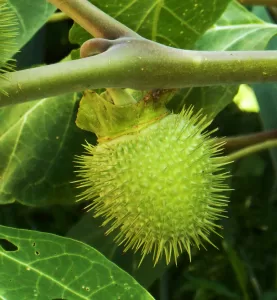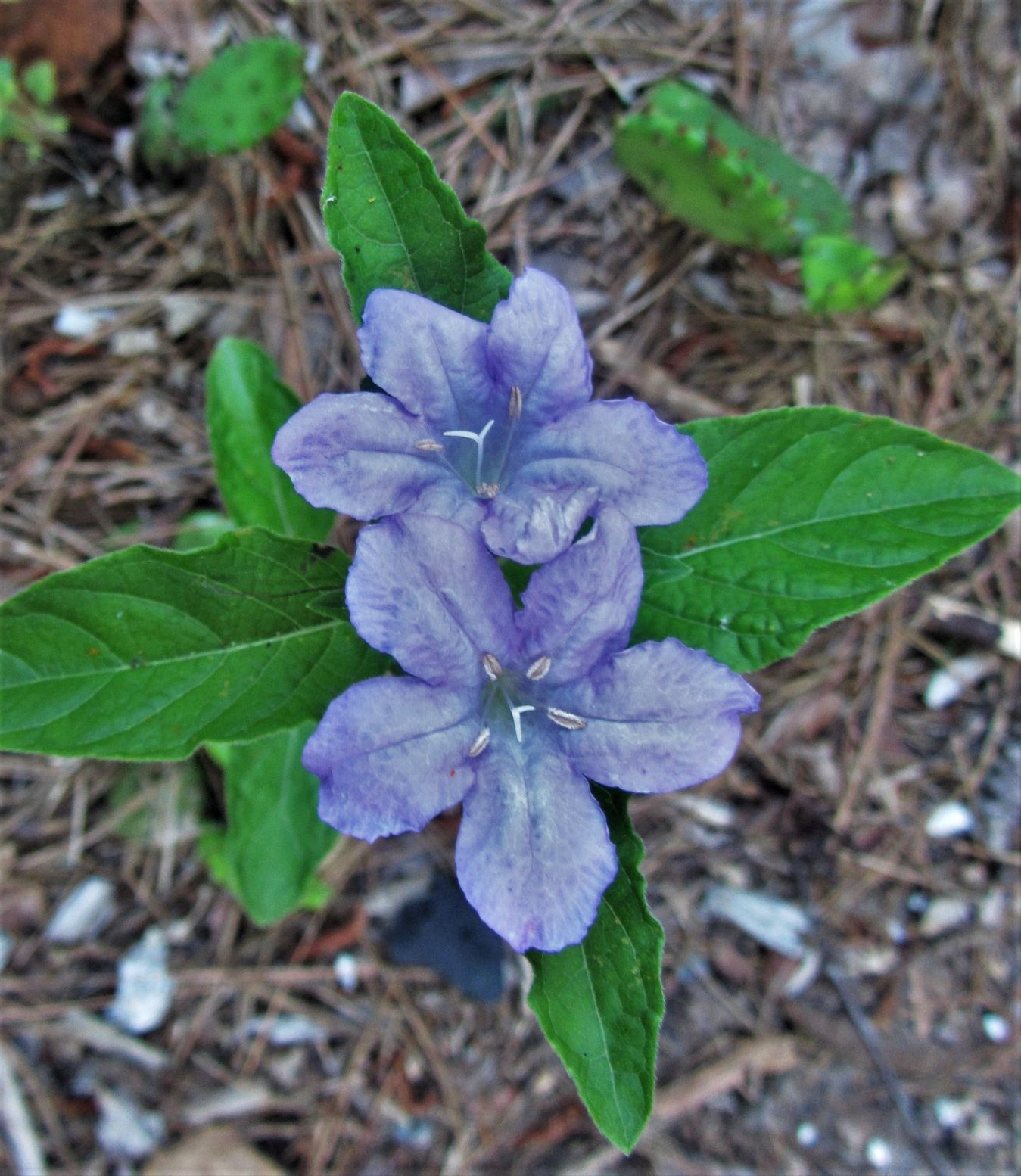Plant Knowledge
“Power rests on the kind of knowledge one holds.
What is the sense of knowing things that are useless?”
Dr. Carlos Castaneda
When a young graduate student in anthropology wanted to learn more about the medicinal uses of plants for his academic research in the early 1960s, so the legend goes, he sought out an old Mexican native, a brujero, known simply as don Juan, who lived in the Sonoran Desert. Carlos asked to interview him about the plants he collected in the desert, and their uses. Carlos Castaneda went on to become don Juan Matus’s apprentice and a part of his circle of shamans and ‘sorcerers’ in Northern Mexico.
Although Carlos eventually earned his doctoral degree at UCLA based on his research, his life was forever changed by the experience. You may have read one or more of Castaneda’s dozen books written about his experiences with the beneficiaries of an ancient indigenous tradition of the Nagual, practiced in Central Mexico. While the degree of truth related in these books is still debated by some, and few of Castaneda’s claims can be proven, they open a window into the contemporary use of various psychoactive plants by some native American groups.
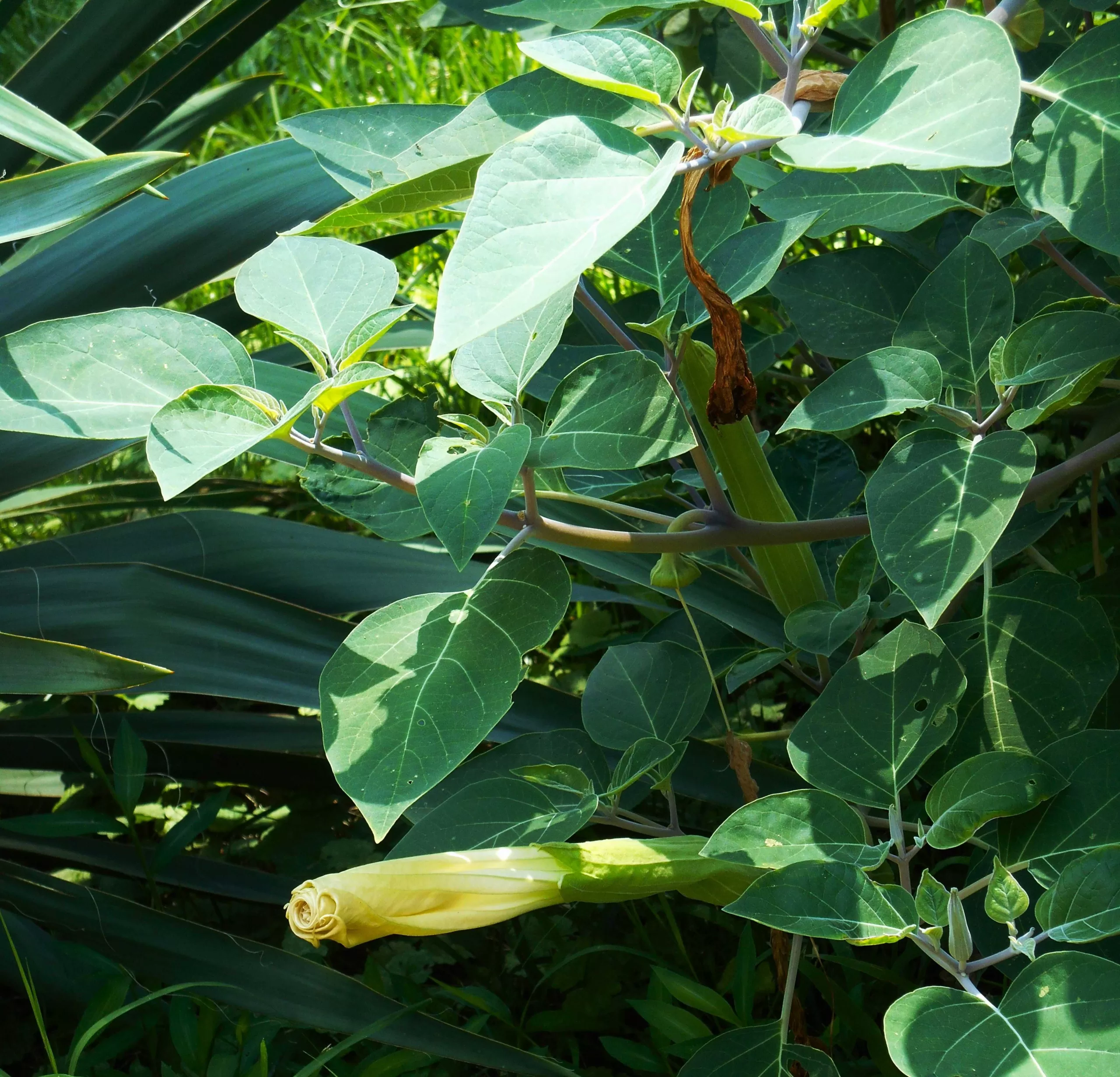
Jimsonweed, Datura stramonium
Power Plants: Entheogens
Castaneda learned about three main ‘power plants’ with his benefactor, don Juan. Peyote, the Teacher, was the gentlest of the three. Under its influence, Carlos met the anthropomorphized spirit of peyote, ‘Mescalito.’ Mescalito taught the indigenous people about the right way to live. Carlos and his companions could see him and converse with him. Groups of Mexicans gathered in the desert during ritual mitotes, to chew peyote and interact with Mescalito together, asking for instructions. There is a Native American Church in North America where ritual peyote use is still an important part of their practice.
A second plant used during Castaneda’s training was jimson weed, Datura stramonium. He had to plant Datura seeds in the desert and personally cultivate the plant over a season, before he could harvest it and prepare it for his own use. Native to the area, all parts of the Datura plant are used either medicinally or ritually. When the jimson weed matured, Carlos carefully dug it up without damaging its roots. The plant was separated into roots, leaves, flowers, and seeds; dried; and then the roots were prepared in a decoction that he later drank.
Datura is an entheogen, a substance used to induce a sacred or occult vision and encounter with ‘non-ordinary’ reality. It allows the user to sense a spiritual and energetic reality about the world normally hidden to them. The alkaloid tropane, found in Datura and other plants, is responsible for the hallucinations and for a variety of unpleasant, disturbing, and sometimes lethal physical effects, including convulsions. The native Algonquin people, of which the Powhatan Nation was a part, used this plant during initiation rituals for young men of the tribe. After a period of training and fasting, they took a potion containing this herb. Their experiences helped them to leave childhood behind and become men of the community.
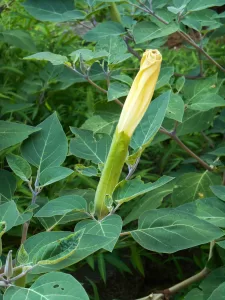
Jimsonweed, or ‘Jamestown weed,’ has grown wild in our area since before colonization.
An alternate common name for this plant is Jamestown weed. History tells us that a group of British soldiers sent to Jamestown to put down Bacon’s Rebellion in 1676 gathered young leaves from the plant, boiled them to eat as ‘salad,’ and spent the next 11 days in a state of comic and good-natured delirium. They had to be isolated and monitored to prevent them from harming others or themselves, and remembered nothing of their experience when they finally came back to their senses.
The third entheogen that don Juan introduced to Carlos was a mushroom in the genus Psilocybe. They gathered the mushrooms in the desert and then put them into gourds to dry for the next year. Once dried and powdered, the mushrooms were mixed with other dried and crumbled herbs and plants, and blended into a smoking mixture called ‘the smoke of the diviners.’ Small quantities were smoked ritually from an ancient pipe, handed down in the lineage. The user’s ‘intent’ and strength of will were especially important when working with this ‘ally,’ because the user’s state of mind and intent going into the experience determined the type of experience one had- whether useful or terrifying.
The smoke, a ‘powerful ally,’ allowed the user to ‘see’ layers of reality that the human brain normally filters out and cannot see. It sharpened and refined the user’s perceptions, allowing him to sense how people, animals, plants, geologic formations, and other things are all connected within a web of glowing filaments of light. It revealed energetic relationships within a world pulsing with energy and life. These changes to perception were necessary to sense and understand the spiritual reality shared by don Juan and his companions, and to interact with their world. It is a common belief among traditional, indigenous cultures that the entire world is alive and sentient, responsive and interconnected.
The combined effects of using these hallucinogenic plants were too much for Carlos, and he left don Juan after four years of work. But Castaneda organized his field notes, wrote and published his first book, and submitted his dissertation at UCLA, before returning to the Sonoran Desert and don Juan a few years later. He came back with a new perspective and completed his apprenticeship.
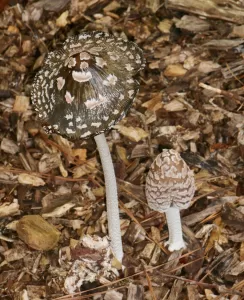
Many different types of mushrooms are poisonous. Never eat wild mushrooms without first making a positive identification to ensure the mushroom is ‘safe’ to eat. Mushrooms will frequently sprout from newly spread mulch.
‘Men and Women of Knowledge’
Wise people have always learned about plants: how to grow them, how to prepare them, and how to use plants to heal and to kill. There is even a long tradition of how to use plants to open the gates of perception to see, hear and interact with a greater ‘bandwidth’ of the world than we normally see, hear, and feel. Part of the tradition of certain plants is that they can connect one to non-human intelligences that may be known as ‘allies,’ or perhaps as ‘gods.’ A key concept across many cultures and throughout history is to show great respect to these plants, and to recognize them as a sort of aware intelligence capable of interaction.
These ‘men and women of knowledge’ may be called medicine people, brujeros, shamans, psychopomps, witches, Druids, or priestesses and priests. They know from their own experiences that plants may give life when eaten as food, but they may also serve as gatekeepers, allies, guides, and teachers when prepared and used in specific ways. And these same plants can kill when mishandled, when improperly prepared, or when too much is taken at once. Using psychoactive plants can be fatal to our old understanding of the world because they transform our understanding of the natural world, and of ourselves.
The Science of Spirituality
Just as elder civilizations learned how to bake bread, brew beer, and ferment wine, so they also learned to cultivate, find, and prepare psychotropic plants and fungi. Anthrobotanists are analyzing the residue in ancient pottery to discover which herbs, and perhaps mushrooms, were mixed into the sacred beer and wine served during the Eleusinian and Dionysian Mystery initiations of the ancient Mediterranean world. Followers of the Greek god Dionysius believed that he ‘lived’ in the grape vines, and that by drinking wine they were communing with him. Candidates for initiation in these mysteries underwent long preparations, which included fasting in the days before the ritual.
Some ethnobotanists are exploring the role of barley, infected with ergot and containing the alkaloid ergotamine, in making the kykeon beverage used by the hierophants, priestesses, and initiates during the Eleusinian rites of Demeter and Persephone. The exact contents and preparation of kykeon, and other sacramental beverages, was a profound secret in the classical world, handed down within family and temple lineages, and protected by threat of death to anyone who disclosed it or misused it outside of the temple rituals. The veil of secrecy held until the 2000 year old mystery traditions were abolished in 392 CE, by the Roman Emperor Theodosius I, at which time they were lost.
Ergot is a fungus which can infect rye, barley, and related grains. It grows as a fungal ‘fruit’ on the head of grain and causes a wide range of physical and psychological symptoms when ingested. It can be toxic in quantity, and killed thousands during the Middle Ages who ate rye bread baked with infected grain. Ergotamine is an entheogen, which when properly administered can give someone the feeling of having a spiritual experience. Ergot also contains Lysergic acid, which is a precursor in the manufacture of Lysergic acid diethylamide, commonly known as LSD.

Learn to recognize highly poisonous plants, like poke weed, Phytolacca americana. It is so poisonous that it can damage one’s chromosomes. It is poisonous even to touch, so wear gloves when handling it. Birds love the fruits of this native plant, which seeds itself around freely. It is a good wildlife plant, but aggressive and dangerous to pets and children, as well as to ‘foragers’ who don’t know it is poisonous.
Other plant-based substances which may have been used in the kykeon include psychoactive mushrooms, poppies, rue, or Acacia. Grass species in the Phalaris genus, which grow in the Mediterranean region, and across all continents except Antarctica, contain the alkaloid DMT, which is psychoactive and can be poisonous in large concentrations. DMT, Dimethyltryptamine, is also contained in nutmeg, mimosa, and even citrus. Our body can normally break it down unless the plant matter is prepared in specific ways to maintain the alkaloid’s psychotropic properties. The knowledge of how to handle these plants, blend and brew them to give seekers the experiences and knowledge they sought, without killing them, was the property of specialized priests and priestesses in the ancient world.
There is even research into what may have been mixed into the wine for the earliest ‘Communion’ sacraments celebrated in the catacombs and underground temples of Greek and Roman cities in the first centuries CE, by the earliest groups of Christians. These mystery sacraments, according to contemporaneous accounts, transported the celebrants to encounters with spiritual beings inaccessible during normal consciousness. Artwork found in these early temples appears to document their experiences. A number of researchers are exploring the hypothesis that the earliest Christian ‘Communion’ may have had much in common with the contemporaneous classical Greek ‘mystery religion’ sacraments , which used specially prepared, psychoactive wines. This practice was punished as heretical once the Romans organized and standardized the practices of the Christian Church under the authority of the Roman Emperors in the 4th Century CE. Like other beliefs and practices of the early Christians, it was abolished as heretical, and mostly erased from history.
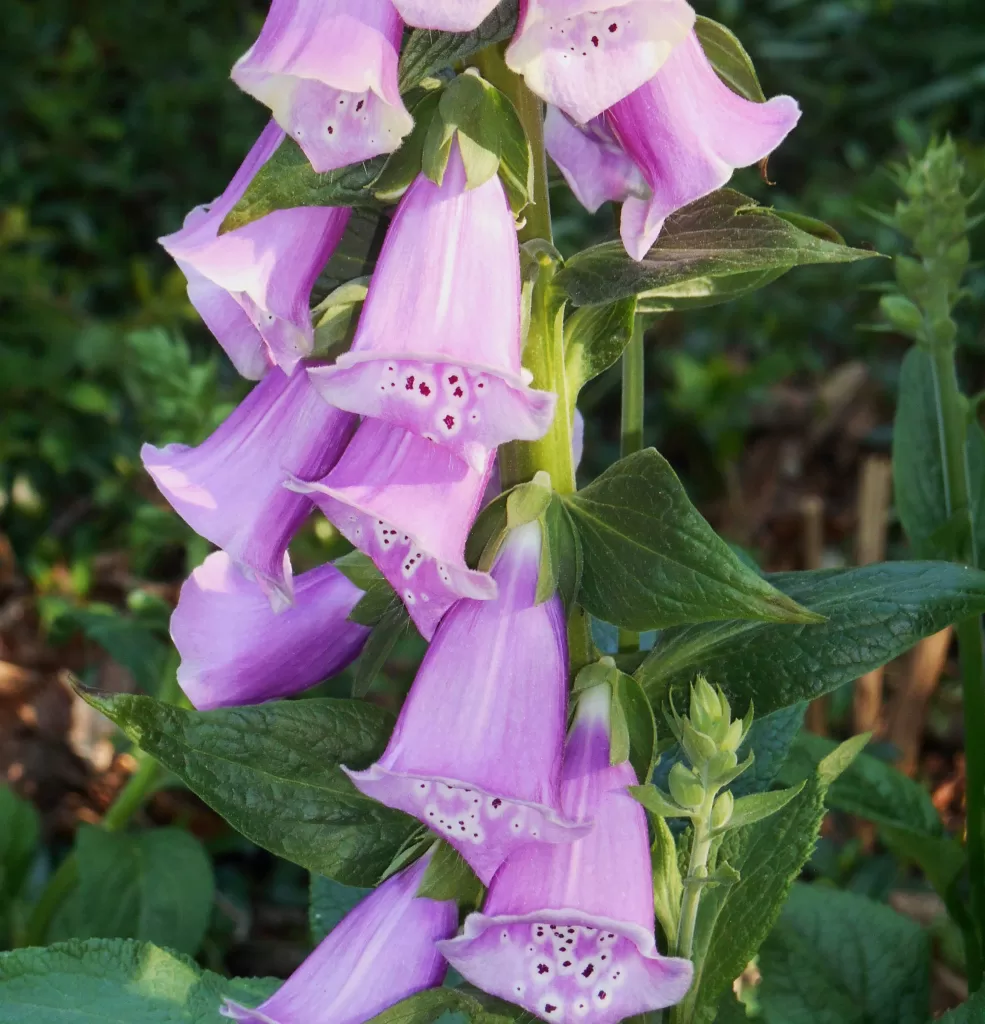
Foxglove, Digitalis purpurea, is the source of a life-saving drug when properly prepared. All parts of the plant are highly poisonous if eaten fresh. This plant is rarely grazed by deer.
It Depends… on How You Use It
There are literally thousands of types of psychotropic plants, and many more that are poisonous to humans and pets, without having the specialized alkaloids and other substances that affect consciousness. Some, like foxglove, Digitalis ssp., are toxic when their seeds, leaves, flowers, or stems are eaten, and yet save lives when extracts from the leaves are prepared as medicine. Native people all over the world learned how to prepare life-saving medicines from the leaves, bark, stems, roots, fruit, and seeds of various plants.
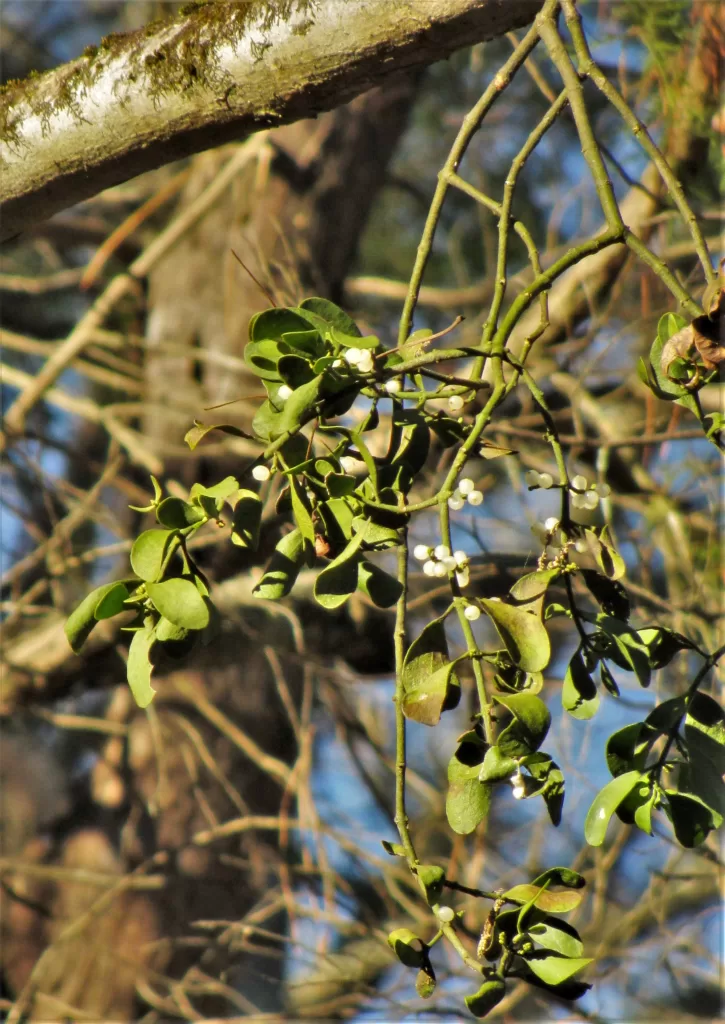
The white berries of American mistletoe, Phoradendron leucarpum, are often mixed with the red berries of holly in holiday decorations. Mistletoe is naturalized in trees throughout our area, seeds sown by the birds. Mistletoe was sacred to the ancient Celtic people and was used medicinally. Whether it was used as an entheogen is a topic of debate among ethnobotanists and neo-Druids.
‘Gifts of the Tree,’ or is it ‘Gifts Under the Tree’?
Shamans of various indigenous groups living in far northern Europe and Asia knew how to find, prepare, and use the ‘sacred’ hallucinogenic mushroom called Aminita muscaria. This mushroom has a red cap with white flecks on it and a white stem. Shamans regularly used hallucinogenic mushrooms to facilitate their vision quests. They also shared these mushrooms, regarded as sacred, with other members of the village.
These special mushrooms grow exclusively under certain trees like pines, firs, cedar, and spruce. Growing in a special relationship with these roots, they are considered “gifts of the tree.” Aminita muscaria still grow throughout much of the northern parts of the Northern Hemisphere and have been spread to many areas of the Southern Hemisphere. Considered poisonous when eaten fresh, skilled shamans prepare them and give them to their followers under the proper conditions to facilitate a spiritual journey, or trip. The mushroom reportedly gives one the sensation of flying, and helps one find the answers to questions about the nature of life and living.
Aminita muscaria is native in Virginia, and depending on the subspecies, may be yellow or orange rather than red. These are highly poisonous, ignored even by the squirrels. The red subspecies may be found in James City County. Mushrooms are not true plants. They are the ‘fruiting body’ of a mycelium, or fungal thread, which grow from wind-blown spores. The mushroom contains spores for the next generation of mycelia. Indigenous people believed they were gifts from their gods because they appeared so suddenly and unexpectedly, without cultivation.
Over 200 species of mushrooms contain psilocybin, which is converted to psilocin, an alkaloid that has effects similar to LSD, mescaline, and other hallucinogenic substances. Some of these mushroom species belong to the genus Psilocybe, while others belong to perhaps a dozen other genera. Cave art discovered in Europe indicates that the use of hallucinogenic mushrooms predates recorded human history. Dr. Albert Hoffman, a Swiss chemist working for Sandoz Laboratories, first isolated psilocybin and psilocin in the laboratory in 1958. Psilocybin was then marketed internationally to clinicians for therapy. We have since learned that the US military and CIA carried out active research with psilocybin and LSD, also isolated by Dr. Hoffman, in the 1960s, and perhaps beyond.
Psilocybin has proved helpful in treating depression, PTSD, for terminally ill individuals, and during ‘end of life’ hospice care. It may have other clinical applications. The problem is in getting it approved for clinical use since it is a ‘controlled substance.’ Only Oregon currently allows individuals to participate in supervised use of psilocybin without a doctor’s prescription.
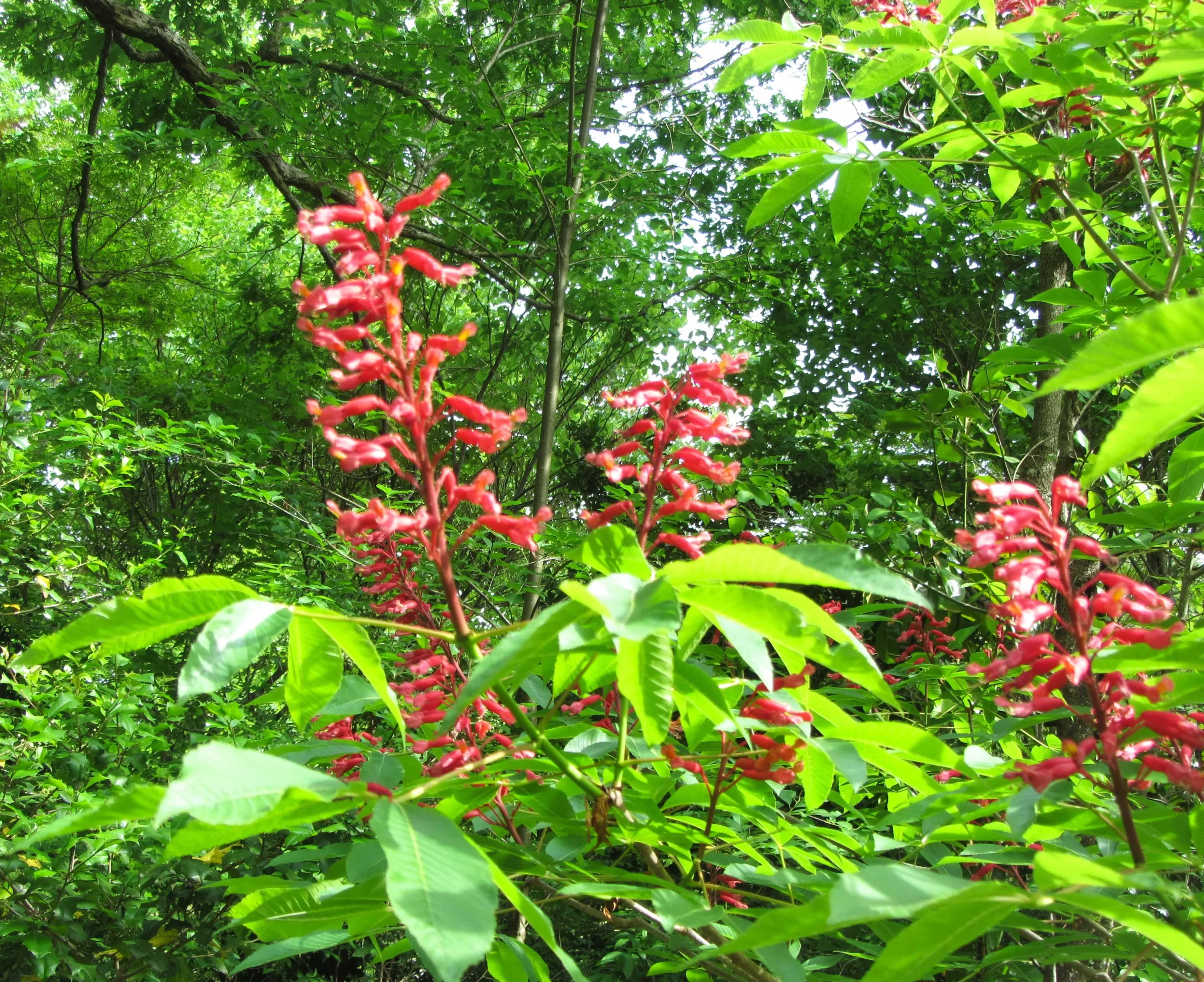
Red buckeye Aesculus pavia, is a highly poisonous tree. Hummingbirds and bees love the flowers, although all parts of the plant are poisonous. Its nuts look a little like chestnuts, but are also highly poisonous.
Preparation is Key
Often the key to a plant’s usefulness is in how it is prepared. Once gathered, psychoactive mushrooms were dried and aged either by hanging them from the branches of conifer trees, or by stringing them and hanging them over the hearth in the shaman’s home. Small bits of the mushroom were then chewed to release their influence. Indigenous shamans in the Southwestern United States and Mexico gather and dry the peyote cactus, Lophophora williamsii, for similar use. This tiny, spineless, round cactus contains Mescaline and other alkaloids. It is considered poisonous, especially if ingested fresh or in large quantities. Archeological digs in Texas discovered peyote in a cave on the Rio Grande that is 5500 years old. Peyote is still used as a sacrament today by various Indigenous American groups, who say that using peyote connects them to God.
In South America, the Indigenous people brew ayahuasca by boiling parts of the Banisteriopsis caapi vine, along with the leaves of the Psychotria viridis shrub, and a variety of other plant ingredients for specific purposes. A decoction is prepared, concentrating the DMT and other alkaloids, through prolonged boiling. This liquid is administered by an experienced shaman and those participating in the experience are supervised.
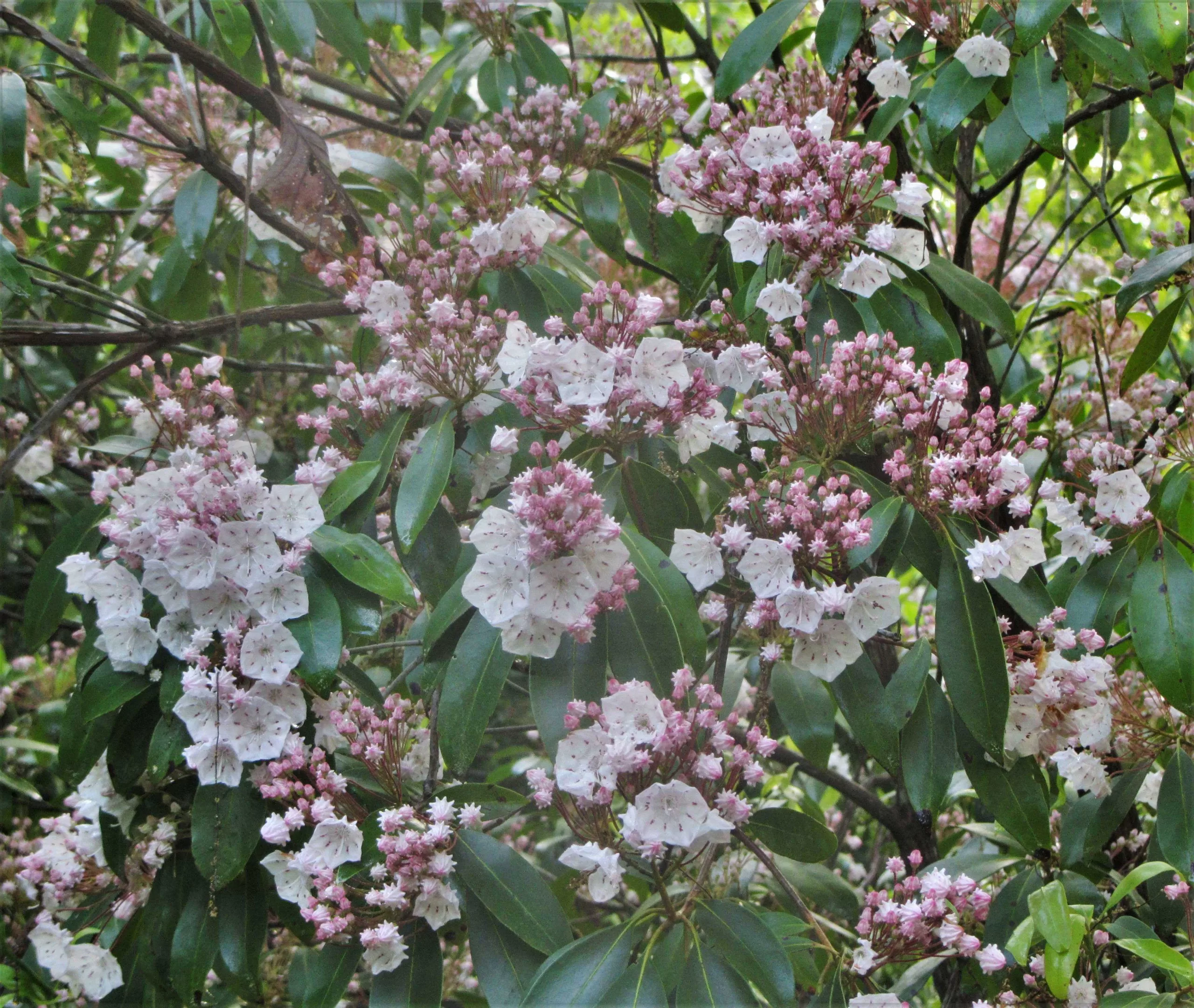
Highly poisonous mountain laurel, Kalmia latifolia.
“Setting and Mindset”
Although people have used these plants medicinally and spiritually for millennia, they aren’t without risk. Because the plants differ in their potency, and the usual dose affects individuals differently, there is always risk. And side effects. Most of these plants cause nausea, often vomiting, sometimes loss of muscle control, and other physical ‘symptoms’ that last for some time. Some have an experience of euphoria while others are terrified. There are long lasting psychological effects both good and bad.
Dr. Timothy Leary and Dr. Richard Alpert documented in their psilocybin research project at Harvard, in the early 1960s, that the setting in which these substances are used, and the mindset or intent of the user, helps determine the sort of experience one has with them. Part of their research involved students from the Harvard Divinity School. Many of those students reported their experiences as positive and helpful. But, like Carlos Castaneda, the researchers were forever changed, in the most profound ways, by their research.
In Self-Defense
Have you ever considered how members of the Plant Kingdom defend themselves? Some have thorns. Some have thick, waxy leaves or tough bark. And many are poisonous. The topic of poisonous plants is not usually considered polite conversation. Yet, it is important to realize that many common garden plants and native plants have poisonous parts. Some plants may be poisonous only if eaten, or if eaten fresh. Others may have poisonous seeds or roots. Some, like poison ivy, may cause skin irritation when touched. Poison ivy has such volatile oils that when the plant is burned, the oils become infused in the air, and can cause harm to lungs and skin when inhaled.
Certain herbs and perennials contain oils that repel animals, and that can be absorbed through the skin for medicinal or psychoactive purposes. Capsaicin, extracted from hot chilies, can relieve muscle pain when applied in a topical cream.
Plants may defend themselves from predators through poisoning those who try to eat them. Or, like holly, they may just cause a reaction if the wrong predator eats them. A native species of holly, Ilex vomitoria, causes extreme nausea to those that eat its leaves, yet birds happily eat its drupes and spread them about.
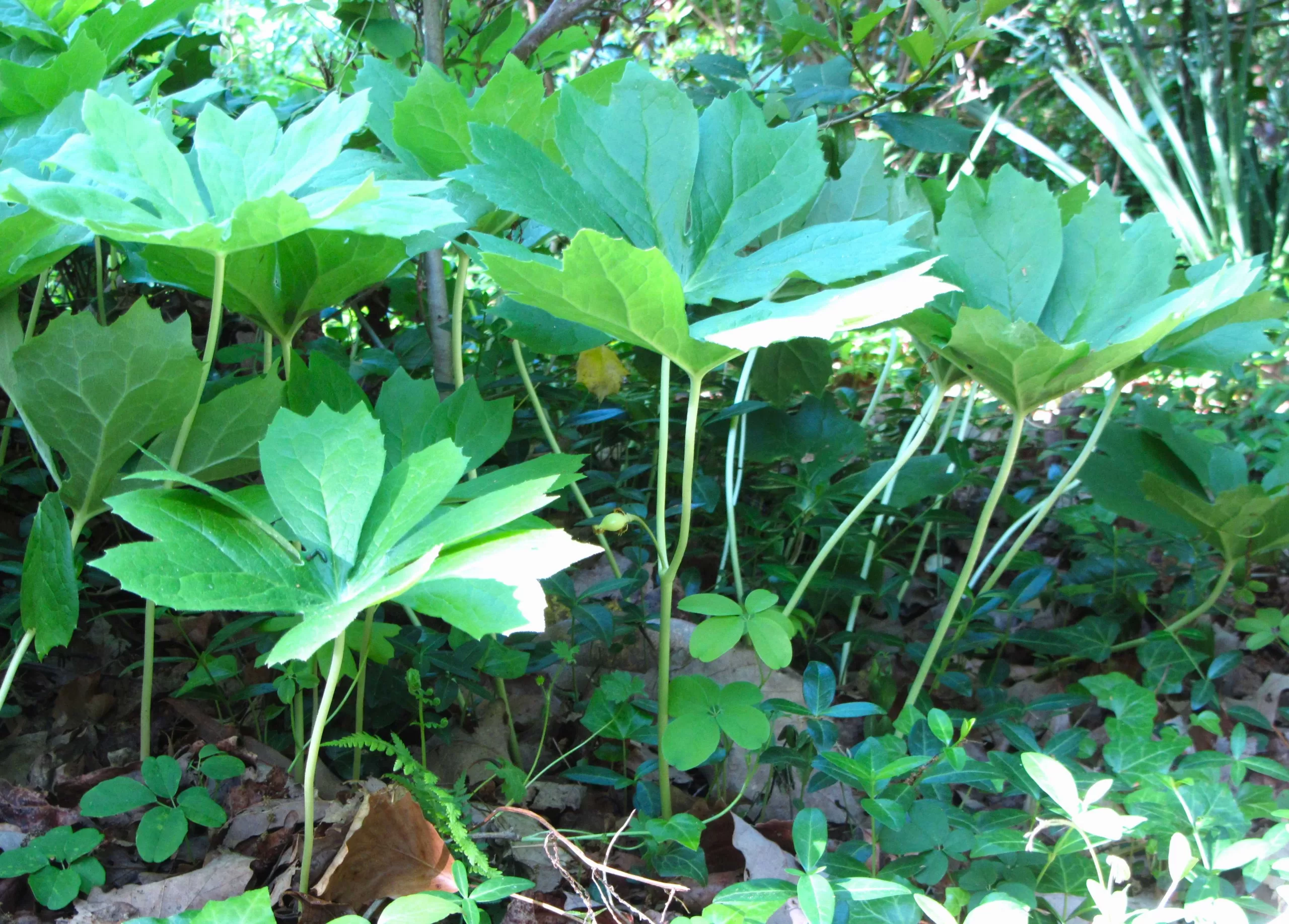
Podophyllum peltatum, mandrake, is commonly known as Mayapple, and is highly poisonous when eaten. The fruit, however, is edible when fully ripe.
To Eat, or Not to Eat?
We all know that both potatoes and tomatoes, members of the Solanaceae family, were considered poisonous until recently in our history. There are 98 genera in this family, which also includes peppers, tobacco, Petunias, eggplant, henbane, jimsonweed or Datura, Brugmansia, and mandrake or Podophyllum peltatum. Substances in these plants, particularly their leaves, have a variety of unpleasant effects on the body, including burning on the lips and tongue, nausea, chills, hallucinations, coma, and death. We know to peel away green tinted potato skins because of the poison in these peels, which have been exposed to light. These same substances protect them from some insects and from some herbivores. Sometimes plant-based poisons have a mild effect, sometimes a deadly one. Some commonly eaten beans, like red kidney and cannellini beans, must be well cooked before they are consumed, to rid the bean of potentially poisonous components which can cause a very upset stomach. One bean from the castor plant, Ricinus communis is said to be sufficient to kill a cow.
Sacred Tobacco
Tobacco, Nicotiana tabacum, is considered sacred to indigenous people and may be used as a type of ‘currency’ to honor, show respect, and reward spiritual beings who are their allies. A pinch of tobacco may be left as a gift to honor a particular tree or geologic formation of importance. There are 79 species in the Nicotiana genus, some that are native in North and South America, southern Africa, Australia, and the South Pacific.
While highly poisonous, especially if eaten fresh, leaves of this plant are harvested, cured, and then processed into cigarettes, cigars, snuff, and pipe tobacco. Tobacco contains nicotine, and other alkaloids. Nicotine is used as a calming agent. Native Americans smoked dried tobacco in their ritual ceremonies, sometimes mixed with other herbs or plants. It may have been a component of don Juan’s ‘smoke of the diviners,’ mixed with the dried mushrooms.
Nicotiana sylvestris, commonly known as Nicotiana, naturalizes as an annual ornamental in many gardens in our area. Many of us grow it for the pollinators without ever considering that it is poisonous.
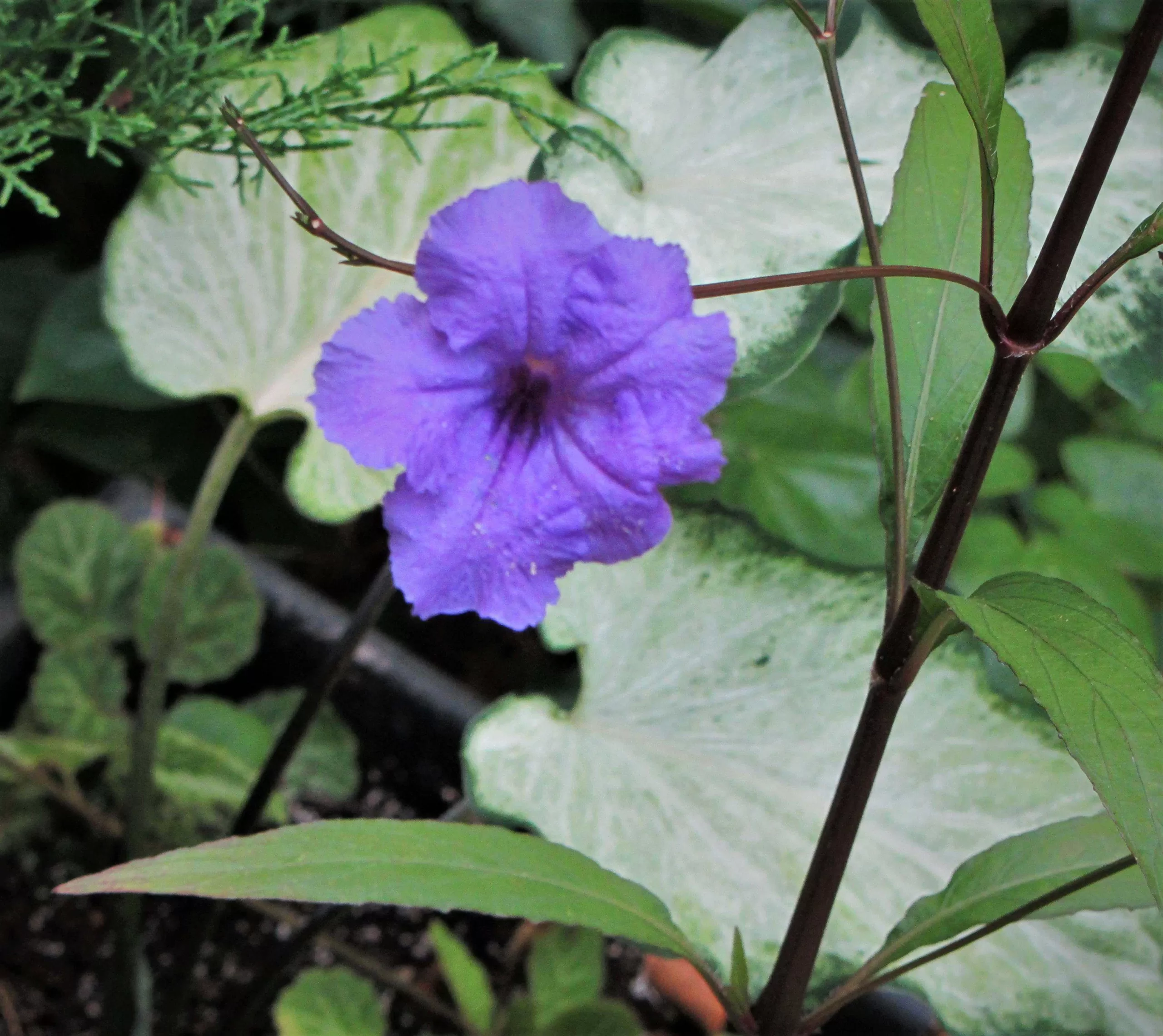
Mexican petunia, Ruellia simplex, blooms near white Caladiums. This perennial petunia isn’t poisonous and may be pruned by deer several times each summer. The Caladium leaf is poisonous, causing irritation in the mouth of any creature who may eat it.
Herbs and Sweet Potatoes
Sweet potato vines, moonflower, and morning glory vines belong to the Ipomoea genus, some species of which are important in indigenous, folk and herbal medicine. Some species are used medicinally, and others as entheogens within shamanistic ceremonies and religious rituals. Potent phytochemicals within the leaves, roots, seeds, and flowers of this genus serve a wide variety of purposes.
Herbs like sage and mugwort, wood or bark like cedar and Acacia, and dried saps like frankincense and myrrh, are just some of the dried plant materials traditionally burned to cleanse or clear a space. Some of these may also have psychoactive properties, especially when inhaled for a long period of time.
Know About What You Grow
Gardeners should know which plants in their yard are poisonous. Those living in more naturalistic areas, who regularly host deer, rabbits, squirrels, snakes, and other animals wandering in from the wild, can profit from this knowledge. Poisonous plants are far more likely to survive the season than those that are not. That said, those of us with small children or pets need a deeper understanding of the relative toxicity of the plants we grow, and what a small child, dog, horse, or cat would have to do to have a problem. If your toddlers don’t normally chew on your shrubs or flowers, there probably won’t be a problem. Older children can be taught which plants are good as food, and which to leave alone.
Curious cats and dogs might have more of a problem with some plants, though most animals are canny about their own survival and will likely leave problematic plants alone. Supervise pets when they are around toxic plants or train them to leave these plants alone. Plants with actively toxic oils, like poison ivy, should be eliminated entirely.
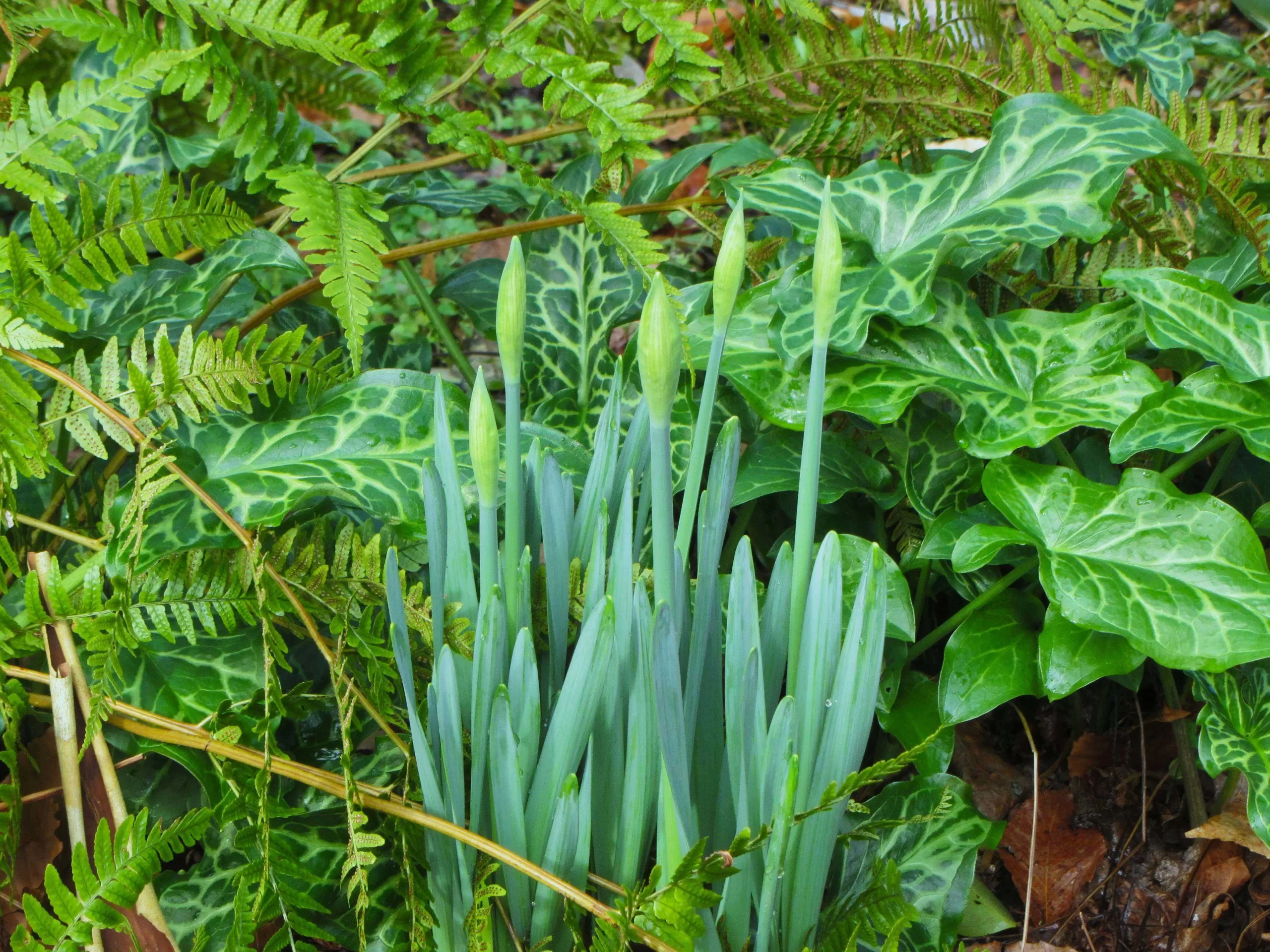
Narcissus and Arum italicum, both highly poisonous, will stop voles wanting to tunnel in the area and neither will be grazed by rabbits or deer. The autumn fern, which isn’t poisonous, benefits from the protection of the poisonous roots of these companion plants, as does the crape myrtle tree growing nearby.
Use Poisonous Plants Strategically in the Garden
Keep in mind that poisonous plants can be used to shield, or protect, other desirable plants that aren’t toxic. Every part of a Narcissus flower is poisonous, including their roots and bulb. Plant Narcissus, and other poisonous bulbs and perennials, like Hellebores, around trees and shrubs you wish to protect from voles and moles, or to disrupt vole tunnels in your yard. Poisonous shrubs, and those with sharp prickles on their leaves, growing around the perimeter of your yard may help discourage deer from frequenting your property. Bulbs in the genus Allium, like onions, garlic and Agapanthus, are known to deter snakes, though we don’t consider all of them poisonous.
We use poisonous plants and plant extracts to protect ourselves and our property from rodents and insects. Cedar wood in the closet or drawers helps to deter moths. Ricin, made from castor beans, kills mice and rats. Cinnamon and capsaicin, from hot chili peppers, help deter ants. Hot chili pepper flakes or powder is sometimes added to bird seed mixtures to deter squirrels. Even cinnamon, with many positive health benefits in small doses, can prove toxic when too much is ingested.
Knowledge is power, so learn as much as you need to about those plants you intend to grow in your garden, indoors, and those you are likely to encounter in recreational areas you visit.
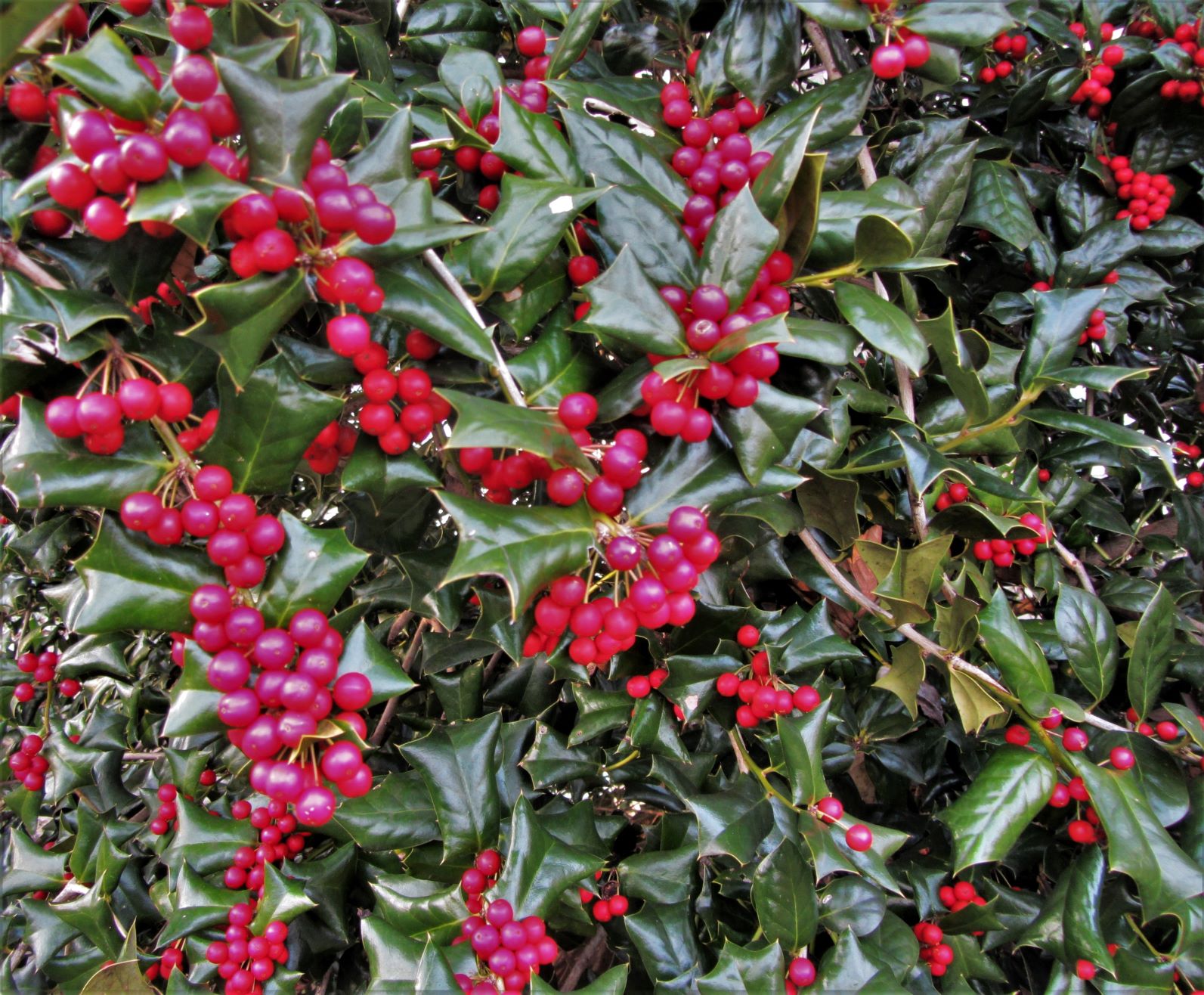
Hybrid Chinese holly, Ilex cornuta, covers itself in berries and provides excellent nesting spots for birds. Consider all types of holly poisonous to ingest.
A Few Poisonous Ornamental Shrubs and Trees:
Aesculus, Buckeye
Azalea
Brugmansia, Angel’s Trumpet:
Datura, Jimsonweed
Daphne
Ilex aquifolium, European holly
Ilex opaca, American holly
Ilex vomitoria, Yaupon holly
Robinia pseudoacacia, Black Locust
Sambucus, Elder
Ligustrum
Kalmia latifolia, mountain laurel
Nandina
Oleander
Rhododendron
Yew
Quercus (some species of oak are poisonous.)
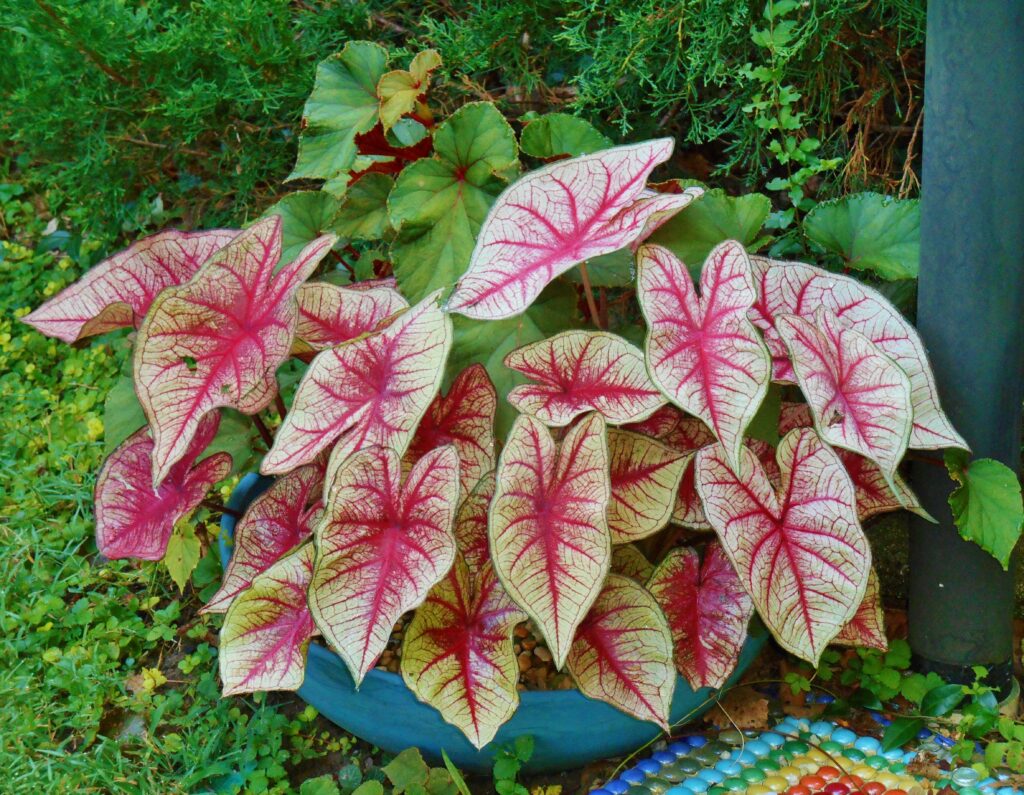
Caladiums are grown for their leaves, which contain calcium oxalate crystals and cause problems for any creature that eats one.
A Few Poisonous Perennials and Bulbs
Arisaema, Jack-in-the-pulpit
Artemesia
Arum italicum, lords and ladies
Aconitum, wolfsbane or monkshood
Caladium
Colocasia, Elephant’s Ear
Columbine
Convallaria majalis, lily of the valley
Delphinium, larkspur
Dicentra cucullaria Bleeding Heart
Digitalis, foxglove
Euphorbia
Galanthus, snowdrop
Hellebore
Hyacinth
Lantana camara
Narcissus, daffodil
Phoradendron leucarpum, American mistletoe
Sauromatum venosum, voodoo lily
Scilla siberica, Siberian squill

Native Wisteria frutecens belongs to the pea family of plants. Many members of the pea family are poisonous to eat.
A Few Poisonous Annuals and Vines
Campsis, trumpet vine
Clematis
Datura stramonium, jimsonweed
Hedera, ivy
Passiflora Caerulea, passion flower
Ricinus communis, castor bean
Solanum dulcamara, nightshade
Wisteria
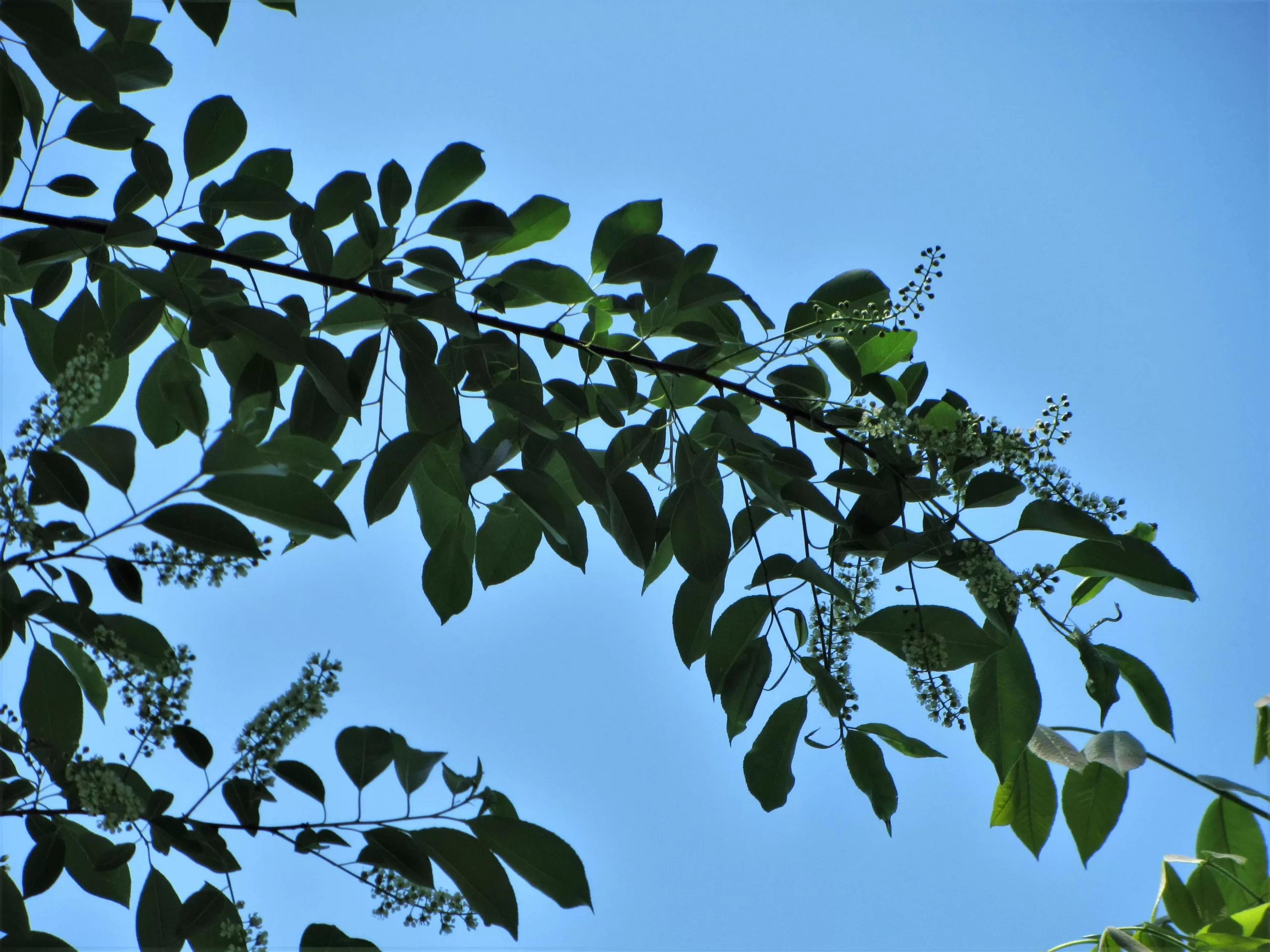
Black cherry, Prunus serotina, is both an excellent plant for wildlife and highly poisonous to humans. All parts of the plant are poisonous except the fruit, but the cherry pits contain poisonous cyanide compounds. This tree is a larval host many lepidoptera species, supports pollinators in the spring, and many animals eat its ripe fruits.
Many of these poisonous plants, like daffodils and mountain laurel, already grow in our gardens, and have for decades. They pose no problems for pets or people. You may be surprised to learn some of these plants are poisonous, as I was. Expect most poisonous landscape plants to be left alone, growing untouched, as their less lethal neighbors are disturbed or grazed by deer, rabbits, or squirrels. All plants have their uses, and it is up to us to learn about them and to use them wisely.
All Photos by Elizabeth McCoy, Master Gardener and Tree Steward
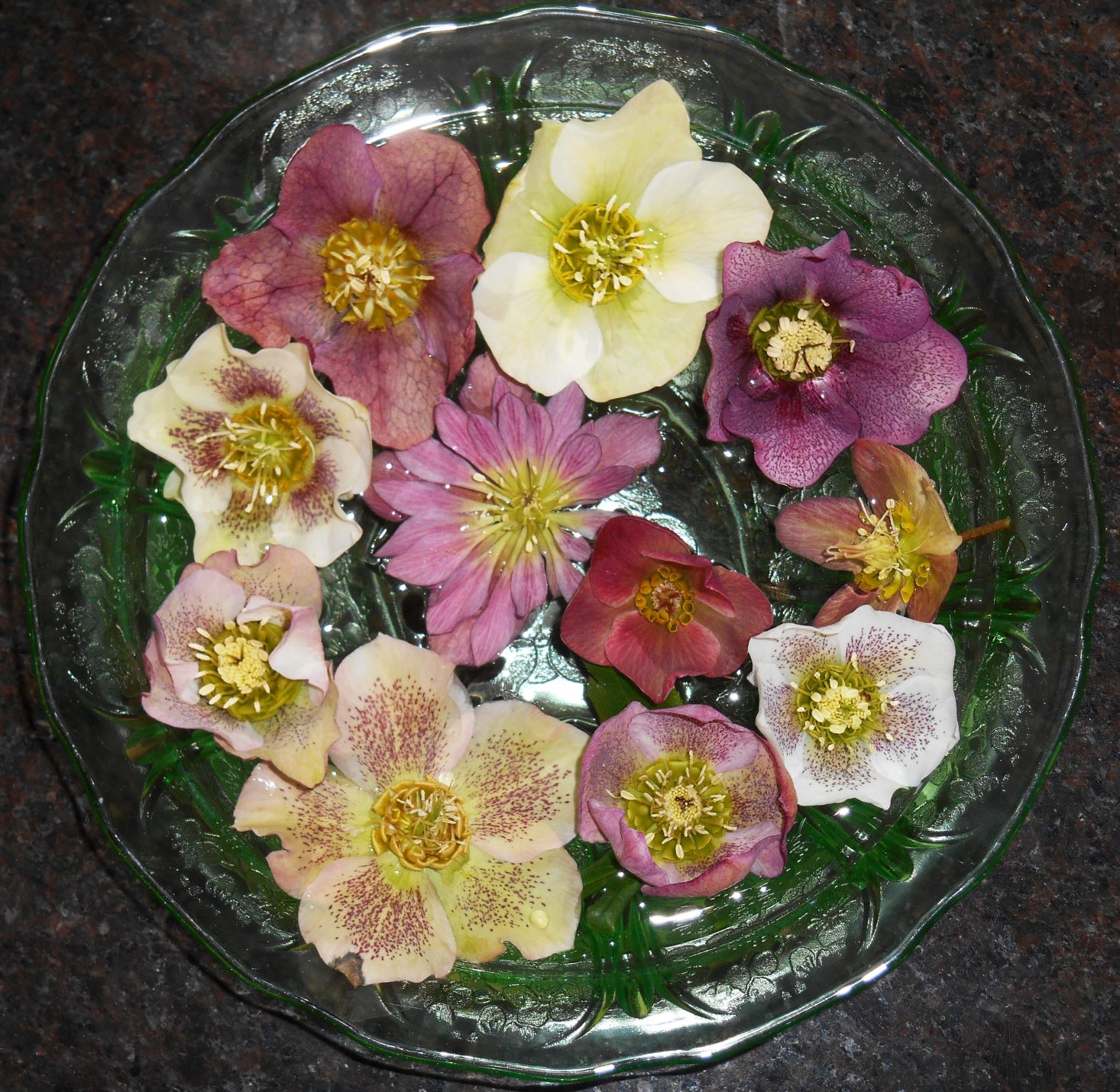
Helleborus flowers are beautiful, support winter pollinators, and are highly toxic to eat. Since all parts of the plant are toxic, even the roots, grow these easy perennials in the shade to protect other plants from voles.
For More Information
Beverley, Robert Jr. The History and Present State of Virginia, Book II: Of the Natural Product and Conveniencies in Its Unimprov’d State, Before the English Went Thither. 1705.
Castaneda, Carlos. The Teachings of Don Juan: A Yaqui Way of Knowledge. Pocket Books. 1968.
Clifton, Margaret, editor for The Virginia Master Naturalist Program and Alfred Goossens, Project Leader. The Socrates Project – Poisonous Plants in Virginia, Second ed., revised and expanded. The University of Virginia. 2020.
Lattin, Don. The Harvard Psychedelic Club: How Timothy Leary, Ram Dass, Huston Smith, and Andrew Weil killed the 1950s and Ushered in a New Age for America. HarperOne. 2009.
Luce, Peter. Getting Castaneda: Understanding Carlos Castaneda. 2017.
Muraresku, Brian C. The Immortality Key: The Secret History of the Religion with No Name. St. Martin’s Press. 2020.
McKenna, Terence. Food of the Gods. The Search for the Original Tree of Knowledge. Bantam Books. 1992.
Paterson, Jacqueline Memory. Tree Wisdom: The definitive guidebook to the myth, folklore, and healing power of Trees. Thorsons. 1997.
Tornio, Stacy. Plants That Can Kill. 101 Toxic Species to Make You Think Twice. Skyhorse Publishing. 2017.
Wasson, R. Gordon, Albert Hofmann, Carl A. P. Ruck, Huston Smith, Peter Webster. The Road to Eleusis: Unveiling the Secret of the Mysteries. North Atlantic Books. 2008.

